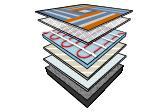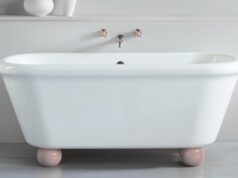
Hydronic heating uses heated water pumped through a network of pipes to radiators. It also works as under-floor heating.

A hydronic heater (also known as a wet heater or hydronic system) is a type of central heating that uses a centralised boiler to heat water then pump hot water to radiators or under-floor heating coils around your home through a network of pipes.
Often, for the sake of efficiency and convenience, the boiler is also used as the main source of hot water for a home. These types of systems use what’s commonly known as a ‘combination boiler’ to achieve this.
How do hydronic heaters work?
Hydronic heaters boil water in a large boiler tank – much like those used in storage tank hot water systems. The boiler is heated in the same way as storage tank hot water systems too – either using gas, electricity, solar energy or solid fuel. As is the case with solar hot water systems, using solar typically requires a gas or electric booster for consistent hot water. The water in the tank is thermostatically controlled, and kept at a constant temperature.
Using a pump, hot water is carried through a network of pipes (typically either insulated copper or PVC) to either radiators, under-slab coils, or convector heaters, where heat is dissipated from the water and converted to convective heat or radiant heat inside the home. The cooler water continues around the piping loop and returns to the boiler.
Radiators, convectors and coils
Radiator panels, despite the name, don’t just emit radiant heat – they also create a considerable amount of convective heat. Radiators typically use either one, two or three panels. As air travels between the panels on radiators with more than one panel, the air is warmed to create convective heat. While single panel radiators mostly provide radiated heat, radiators with two or three panels create more convective heat than they do radiant heat. The ‘fins’ and channels that make up the surface of the radiator are also responsible for creating convective heat, by warming the air in between them.
The other type of panel is the ‘convector panel’ – this uses a heat exchanger to turn the heat from the circulated water directly into convective heat. Below is a comparison table roughly showing the proportions of radiated and convected heat given out by each different type of panel:
| Radiator and convector panel output ratios | ||||||||
|---|---|---|---|---|---|---|---|---|
| Panel type | Radiant heat (%) | Convective heat (%) | ||||||
| Single panel radiator | 70 | 30 | ||||||
| Double panel radiator | 50 | 50 | ||||||
| Triple panel radiator | 30 | 70 | ||||||
| Convector panel | 0 | 100 | ||||||
| Source: Sustainable Energy Authority, Victoria, 2004. | ||||||||

Another mechanism used to distribute heat using a hydronic heating system is baseboard convectors. These replace the conventional baseboards (also known as kickboards), and come in a variety of styles to provide radiant heat, convective heat or a combination of both.
Under-floor (or slab-based) heating pipes typically consist of polyethylene pipes coiled around the area to be heated. These radiate heat up through the floor. Combinations of radiators and under-floor heating systems are possible, but the two types of systems are normally installed separately. Radiators and under-floor heating systems require the water to be at different temperatures.
Maintenance
All of these systems must have ways of eliminating air from the piping, without letting the water out. A build up of oxygen in the pipes can lead to corrosion and loud noises from within. The most common way of getting rid of air is through a bleed valve. Hydronic systems should also feature a pressure relief valve to avoid pipes bursting, which can cause a considerable damage to your home. This should be regularly tested or inspected according to the installer’s instructions.
|
Advantages
|
Disadvantages
|





